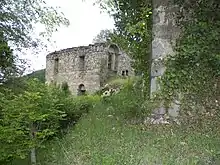Vachagan III
Vachagan III the Pious (Old Armenian: Վաչագան բարեպաշտ, romanized: Vačʿagan Barepašt) or Vachagan II (according to some authors) was the last Arsacid king of Caucasian Albania, ruling approximately from 485 to 523.
| Vachagan III | |
|---|---|
 The Yeghishe Arakyal Monastery, where Vachagan III is buried | |
| King of Caucasian Albania | |
| Reign | 485–523 |
| Predecessor | Vache II |
| Spouse | Shushanik |
| Issue | Pantaleon Khanchik |
| House | Arsacid |
| Father | Aswagen or Yazdegerd II |
| Religion | Church of Caucasian Albania |
Background
His lineage is uncertain. Murtazali Gadjiev considers him a son (or nephew) of the King of Kings (shahanshah) Yazdegerd II (r. 438–457) and brother (or nephew) of Vache II.[1] However, Aleksan Hakobyan refers to 5th century Armenian historian Elishe's mention of Vache as "a son inherited families", concluding that Vache was not heir but a second son. Hence, according to him, Vachagan was the son of elder but deceased son of Aswagen, thus a nephew of Vache II.[2]
Reign
Vache II previously ruled Caucasian Albania as a Sasanian vassal, but had been forced to abdicate after his revolt was crushed by Yazdegerd II's son and successor Peroz I (r. 457–484) in 462.[3][4] Albania would remain kingless until 485, when Vachagan III was installed on the throne by Peroz's brother and successor Balash (r. 484–488).[4] This happened around the time of the signing of the Treaty of Nvarsak.[3] The 6th-century Syriac author Zacharias Rhetor reports the siege of the Byzantine city of Amida by the Sasanian forces. After the city was captured in January 503, the victors started plundering the city and capturing prisoners. While this took place, mention is made of a "Christian prince of the country of Aran pleaded with the (Persian) king on behalf of one church, called the Church of the Forty Martyrs, and he spared it while it was full of people." Modern historian Murtazali Gadjiev deduces that the Christian prince described is "without a doubt" Vachagan III.[3] Although sources don't give date for end of Vachagan's reign, Hakobyan puts it into 523, about the time of Kavad I's invasion of Georgia and abolishment of Iberian monarchy.[2]
Family
The History of the Country of Albania provides names of two children of Vachagan - a son, Pantaleon, named after Saint Pantaleon and a daughter named Khanchik. His wife, named Shushanik (Old Armenian: Շուշանիկ) was probably a Mamikonian princess.[2]
Legend
Vachagan is presented in The History of the Country of Albania as a staunch Christian who ordered the Albanian aristocrats who had apostatized to return to their Christian beliefs. Furthermore, he also declared war against Zoroastrianism, Paganism, idolatry and witchcraft.[4] He opened religious schools in the country and recovered the Grigoris' and Saint Pantaleon's relics and buried them in a tomb within the Amaras Monastery with help of his uncle Khochkorik.[5] Hakobyan considers chapter on Vachagan's life as a tale and an image of the ideal and the good Christian ruler.[2] He is traditionally assumed to be buried in Yeghishe Arakyal Monastery.
Legacy
Vachagan's rule in Albania was characterized by gradual Armenianization of the country, relying on Armenian feudals. Hakobyan believes this when Armenians came to consider Albania as an Armenian realm too.[2] Later princely houses from region Aranshahiks (authors such as Patrick Donabedian[6] and Bagrat Ulubabyan are supporters of this theory) and Hasan-Jalalyans claimed descent from him. Vachagan became a symbol of renewal in Nagorno-Karabakh, some Armenian authors even credit him as an author of first Armenian constitution erraneously,[7] there is also a state "Order of Vachagan the Pious" in Nagorno-Karabakh Republic.[2] Armenian tale of Anahit and Vachagan is loosely based on Vachagan's life. The tale was retold as romantic prose by Ghazaros Aghayan[2] and children's book by Robert San Souci.[8]
References
- Gadjiev 2020, p. 32.
- Hakobyan, Aleksan (2021-07-19). The Creation of a “Pious” Image of King Vačʽagan II (r. c. 485–523) of Caucasian Albania in the Tale of Vačʽagan (Early Sixth Century). De Gruyter. doi:10.1515/9783110725612-012. ISBN 978-3-11-072561-2.
- Gadjiev 2020, p. 33.
- Chaumont 1985, pp. 806–810.
- (in French) Mahé, Jean-Pierre, "Vač'agan III le Pieux et le culte des reliques," Revue des Études Arméniennes 35 (2013): 113-29.
- Chorbajian, Levon; Donabédian, Patrick; Mutafian, Claude (1994). The Caucasian Knot: The History & Geopolitics of Nagorno-Karabagh. Zed Books. p. 90. ISBN 978-1-85649-288-1.
- "European values were present in Karabakh, 1,500 years ago". news.am. Retrieved 2022-01-07.
- San Souci, Robert D. (1998). A weave of words : an Armenian tale. Raúl Colón. New York: Orchard Books. ISBN 0-531-30053-6. OCLC 36225467.
Sources
- Chaumont, M. L. (1985). "Albania". Encyclopaedia Iranica, Vol. I, Fasc. 8. pp. 806–810.
- Chaumont, M. L.; Schippmann, K. (1988). "Balāš". Encyclopaedia Iranica, Vol. III, Fasc. 6. pp. 574–580.
- Gadjiev, Murtazali (2017). Construction Activities of Kavād I in Caucasian Albania. Brill. pp. 121–131.
- Gadjiev, Murtazali (2020). "The Chronology of the Arsacid Albanians". Gorgias Press: 29–35.
{{cite journal}}: Cite journal requires|journal=(help) - Schippmann, Klaus (1999). "Fīrūz". Encyclopaedia Iranica, Vol. IX, Fasc. 6. pp. 631–632.